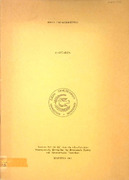Please use this identifier to cite or link to this item:
https://dspace.larlib.gr/handle/123456789/1652Full metadata record
| DC Field | Value | Language |
|---|---|---|
| dc.contributor.author | Παπαδημητρίου, Μαρία, Φιλόλογος | - |
| dc.date.accessioned | 2023-03-20T13:59:14Z | - |
| dc.date.available | 2023-03-20T13:59:14Z | - |
| dc.date.issued | 1982 | - |
| dc.identifier.uri | https://dspace.larlib.gr/handle/123456789/1652 | - |
| dc.description | Στη μελέτη μας θα ακολουθήσουμε τον εξής δρόμο: Θα κατατάξουμε όλες τις περιπτώσεις που ο Δονάτος χαρακτηρίζει με τον όρο "παρέλκον" σε κατηγορίες με βάση τα κοινά στοιχεία που παρουσιάζουν. Έπειτα θα εξετάσουμε τι ρόλο γραμματικό ή συντακτικό παίζουν τα στοιχεία που απαρτίζουν καθεμιά απ’ αυτές τις περιπτώσεις. Θα παραθέσουμε τους συνηθισμένους τρόπους σύνταξης σε παρόμοιες περιπτώσεις, παραπλήσιες συντάξεις ή εκφράσεις της Λατινικής καθώς και όμοιες περιπτώσεις της Αρχαίας Ελληνικής. Σκοπός μας θα είναι να διαπιστώσουμε κατά πόσο είναι πραγματικά ή φαινομενικά πλεονασμοί, αν είναι συνηθισμένοι τρόποι έκφρασης που καθιερώθηκαν στη γλώσσα χωρίς κανείς να υποψιάζεται την πλεοναστική τους απόχρωση, αν είναι συντάξεις ή εκφράσεις που ήταν σε χρήση την εποχή του Τερεντίου και στην κλασική εποχή εγκαταλείφθηκαν με την προσπάθεια για καθαρολογία, αν εξυπηρετούν τη σαφήνεια του κειμένου και αν ο Τερέντιος τους χρησιμοποιεί επιδιώκοντας κάποιο αποτέλεσμα που εξυπηρετεί την κωμωδία του. | el_GR |
| dc.description.abstract | Donatus, the commentator of Terence, uses the term παρέλκον meaning pleonasm in comments on 41 lines of Terence's comedies. The analysis of these lines shows that: a number of them are expressions and constructions common in Old Latin and consequently in Terence (i. e. Andr. 55, 90; Eun. 884, 1032; Ilea 67, 400; Adel. 366; Phor. 80, 172, 250); most of them are real pleonasms but the fact that they are commonly used (especially in everyday language) made undetectable that they are pleonasms (i.e: Andr. 29, 184, 201, 205, 291, 579, 591, 823; Eun. 356, 694; Hec. 131, 192, 250, 734; Adel. 290, 887, 975; Phor. 228, 325); some of them are emphatic constructions which look like pleonasms (i.e. Eun. 150, 393, 721; Adel. 306, 382); and in some cases Donatus is wrong (i. e. Andr. 70; Adel. 528; Phor. 88, 89, 90, 332, 659). Also we can find Greek equivalents of some of these expressions and constructions. Studying these lines we realize that Terence very skifully uses Latin language and Donatus on his part analyzes all the peculiarities of Terence's language and the elements of his style in the way of a modern scholar. Finally statistics can show that old people use παρέλκον more than other characters and we may say that Terence uses this figure of speech in his effort at differentiating characters by linguistic means. | el_GR |
| dc.language.iso | other | el_GR |
| dc.subject | Terentius Afer Publius -- Ερμηνεία και κριτική | Donatus Aelius -- Ερμηνεία και κριτική - Λατινικό δράμα -- Ιστορία και κριτική | Λατινική λογοτεχνία -- Ιστορία και κριτική | Λατινική φιλολογία | Λατινική γλώσσα -- Σύνταξη | el_GR |
| dc.title | Παρέλκον : μια υφολογική παρατήρηση του Αίλιου Δονάτου στον Τερέντιο | el_GR |
| dc.type | Other | el_GR |
| Appears in Collections: | ΑΝΑΤΥΠΑ | |
Files in This Item:
| File | Description | Size | Format | |
|---|---|---|---|---|
| Παρέλκον- μια υφολογική παρατήρηση του Αίλιου Δονάτου στον Τερέντιο -Μαρία Παπαδημητρίου.pdf Until 2099-01-01 | 920.61 kB | Adobe PDF |  View/Open Request a copy |
Items in DSpace are protected by copyright, with all rights reserved, unless otherwise indicated.


